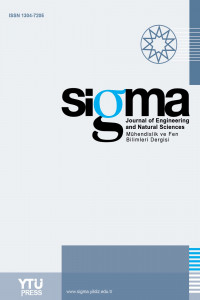Abstract
The purpose of this paper is to examine the effect of strand configuration on the behavior of precast, pre-tensioned concrete I-girders by considering design load components for highway bridges as dead loads and equivalent lane loads. Under these loads, bridge girder’s bottom flange is exposed to tensile stresses. To minimize or eliminate the tensile stresses, compressive stresses are induced in pre-stressed concrete with strands. Determination of strand configuration is important as well as number of strands because it affects stress distribution and displacement of bridge girders. One of the typical precast I-girder with 90 cm height is considered in this study. To determine strand configuration effects, eighteen I-girders with the same cross-section, effective span length and material properties but different strand configuration are selected as an application. Equal prestressing force is applied all strands simultaneously. Three dimensional finite element (FE) models of girder are constituted using ANSYS software. Result of beam theory is used to verify the modeling techniques. At the end of the study, numerically identified stress distribution and displacement for I-girders compared with each other. It is seen that proper strand configuration is effective to reducing stresses and displacements of pre-stressed I-girder.
References
- [1] Rana, S., Ahsan, R., and Ghani, S.N. (2010). “Design of prestressed concrete I-girder bridge superstructure using optimization algorithm.” IABSE-JSCE Joint Conference on Advances in Bridge Engineering-II, Dhaka, Bangladesh, August.
- [2] Tan, KH. and Ng, CK. (1997). “Effects of deviators and strand configuration on behavior of externally prestressed beams.” ACI Structural Journal, 94(1), 13-22.
- [3] Kannel, J., French, C. and Stolarski, H. (1997). “Release methodology of strands to reduce end cracking in pretensioned concrete girders.” PCI Journal, 42 (1): 42-54.
- [4] Moon, J.H., Shin, K.J., Lim, J.H. and Lee, SH. (2000). “Effects of stressed and unstressed reinforcements on prestressed concrete members with unbonded strands.” KCI Concrete Journal, 12(1), 131-138.
- [5] Brice, R., Khaleghi, B. and Seguirant, S. J. (2009). “Design optimization for fabrication of pretensioned concrete bridge girders: An example problem.” PCI Journal, 54(4), 73-111.
- [6] Tadros, M.K., Baddie S.S., and Tuan C.Y. (2010) “Evaluation and repair procedures for precast/prestressed concrete girders with longitudinal cracking in the web.” National Cooperative Highway Research Program report 654. Washington, DC: Transportation Research Board.
- [7] Okumus, P. and Oliva, M. G. (2013). “Evaluation of crack control methods for end zone cracking in prestressed concrete bridge girder.” PCI Journal, 58(2), 91-105.
- [8] Okumus, P., Oliva, M. G. and Becker, S. (2012). “Nonlinear finite element modeling of cracking at ends of pretensioned bridge girders.” Engineering Structure, 40, 267-275.
- [9] ANSYS, (2015). Swanson Analysis System, USA.
- [10] AASHTO. (2012). LRFD Bridge design specifications, 6th Ed., Washington, D.C.
Details
| Primary Language | English |
|---|---|
| Subjects | Engineering |
| Journal Section | Research Articles |
| Authors | |
| Publication Date | March 1, 2018 |
| Submission Date | March 9, 2017 |
| Published in Issue | Year 2018 Volume: 36 Issue: 1 |
IMPORTANT NOTE: JOURNAL SUBMISSION LINK https://eds.yildiz.edu.tr/sigma/


